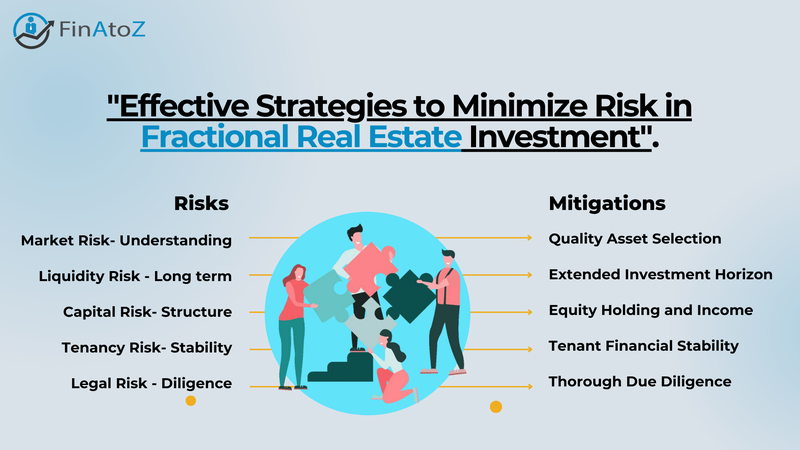"Effective Strategies to Minimize Risk in Fractional Real Estate Investment"

"Explore the landscape of Fractional Real Estate (FRE) as we navigate the path to unlocking benefits in commercial real estate. Just like any investment, the FRE model comes with its unique set of risks. In this article, we dissect these risks, offering valuable insights for those considering investments in Fractional Real Estate.
Join us as we provide guidance on effective strategies to mitigate these risks and pave the way for secure and prosperous investments.
To learn more about Fractional Real Estate, click the following link: Fractional Ownership in Real Estate: The Emergence of New Age Investing in Real Estate | FinAtoZ Blog
1. Market Risk
Market risk stems from the demand and supply dynamics of the property market. Updated assessments of demand and supply are frequently provided by JLL, Knight Frank and Cushman & Wakefield.
Knowing about demand-supply, current market sentiments and future economic outlook can help gauge whether market conditions will evolve in a conducive manner to drive capital appreciation. By investing in a high-quality asset (Grade A, Platinum Rated) located in a rapidly developing area, the market risk associated with your Fractional Real Estate investment will be lowered.
2. Liquidity Risk
Unlike stocks, bonds and mutual funds, real estate is a highly illiquid asset class. Therefore, liquidity risk is higher for investors who wish to exit their Fractional Real Estate investment in less than 5 years.
The primary benefit from Fractional Real Estate investments arises from value appreciation. Value appreciation in commercial real estate can be realized by staying invested over an investment horizon exceeding 5 years. In the long term (5 + years), economic growth, increased demand, and bullish market sentiments will drive the required value appreciation in the asset which can then enable you to liquidate your investment profitably.
3. Capital Risk
Investments in Fractional Real Estate projects are structured to be held as equity shares and Compulsorily Convertible Debentures (CCD) of a private limited company which is incorporated for the sole purpose of owning the asset. By virtue of holding shares of the private limited company, you own the assets.
Given this structure, you not only own the asset but also entitled to receive monthly rental income paid as interest on CCDs. The private limited company is duty bound to comply with all statutory requirements ranging from holding general meetings to filing returns. With capital appreciation at play, your invested capital is unlikely to be adversely impacted by cyclical pitfalls. Therefore, your capital is secure, and risk is minimal.
4. Tenancy Risk
Tenancy risk is relatively low as all properties open for Fractional Real Estate investments are pre-leased to tenants having an agreed lease and lock-in period.
However, tenancy risk can arise if tenants occupying the property face financial issues or vacate the property before the completion of their lease term. In either case your cash flows from rental income will be adversely impacted.
Ideally, the best way to mitigate tenancy risk is to opt for Fractional Real Estate assets housing financially stable tenants. A financially stable tenant is one that does not default/lag on their rent, pays a higher security deposit (6 months+) and is unlikely to vacate the premises. Such tenants not only provide stability to your investment but also contribute to value appreciation of the asset.
5. Legal Risk
Real estate is vulnerable to severe legal and litigation issues if adequate legal diligence is not done. Prior to investing, investors must verify if the Fractional Real Estate investment provider has conducted thorough technical and legal diligence of the property in conjunction with a top tier law firm.
Legal documents must state the property’s Title is clear, confirming the property belongs to the seller and no 3rd party has claim over it. Furthermore, investors must validate if the property has met all clearances and received the required approvals from the governing bodies. Thorough due diligence ensures your investment is safe from legal risks.
Conclusion
While Fractional Real Estate (FRE) investments pose medium to low risks, diversification remains key to a robust investment portfolio. Spread your FRE investments across varied real estate categories like Office, Warehousing, and Residential properties. Geographical diversification further shields against localized market fluctuations. By employing a diversified approach coupled with proactive risk mitigation strategies discussed above, you secure your FRE investments, enhancing their potential for providing stable, long-term returns."

